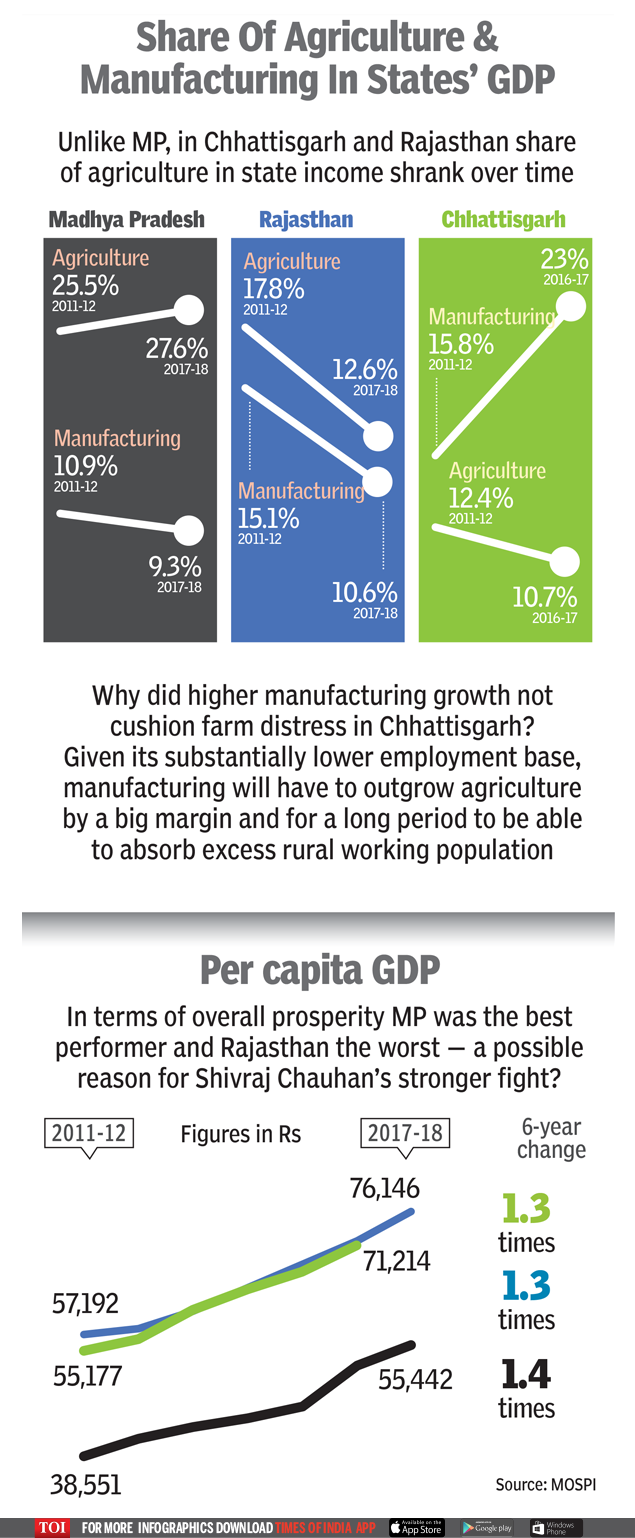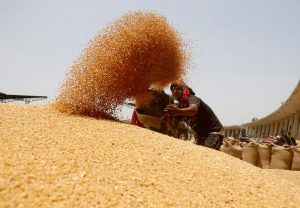
NEW DELHI: When the poll results came in on Tuesday, one thing was clear: BJP had taken a hit in rural areas. And this despite the Centre allocating large sums for several schemes to boost farmer incomes. So what went wrong? TOI takes a look at the stress points hurting the sector.
1. Two years of drought
Two successive years of drought (2014, 2015) have taken a toll on the farm sector. The government has allocated significant funds for the sector but slow implementation of projects has not eased the pain. Drought in Maharashtra, Gujarat, and Karnataka have also added to farmers’ woes.
2. Collapsing farm prices
EXPLORE BRIEFSMore central teams for 10 states that have witnessed or are witnessing high COVID-19 cases: Health ministryThe health ministry has decided to deploy central teams in 10 states that have witnessed or are witnessing high COVID-19 cases to assist their health departments to facilitate management of the outbreak. These are besides the 20 central teams of public health experts sent earlier to 20 high case-load districts on May 3. Not anticipating worst situation in India: Harsh Vardhan on Covid-19 pandemicUnion health minister Harsh Vardhan on Saturday said that he does not anticipate a “very worst type of situation” in India like in many developed countries due to the Covid-19 pandemic, but the government is prepared. Vardhan said the doubling time of coronavirus cases in the country for the last 3 days has been about 11 days & 9.9 days for the last 7 days. Prices have collapsed for farm commodities. Low international prices have meant exports have been hit while imports have hurt prices at home. For example, there was a bumper production of pulses in 2016-17 but imports of nearly 6.6 million tonnes arrived, compounding the problem. In 2017-18, another 5.6 million tonnes flowed in, depressing domestic prices further. The government delayed imposing tariffs on imports, which heightened the problem of prices for farmers. According to a Niti Aayog paper, on average, farmers do not realize remunerative prices due to the limited reach of the minimum support prices (MSP) and an agricultural marketing system that delivers only a small fraction of the final price to the actual farmer.


3. Insurance fails to serve
The Pradhan Mantri Fasal Bima Yojana was launched in 2016 to provide insurance and financial support to farmers in the event of failure of any crops due to natural calamities, pests, and diseases. It was also meant to stabilize the income of farmers and ensure they remain in farming. However, the scheme has seen lower enrolments due to a string of factors, including high premiums and a lack of innovation by insurance firms.
4. Irrigation takes a hit
Irrigation is crucial for the farm sector, where large tracts of land still depend on monsoon rains. The Centre launched the Rs 40,000-crore Long-Term Irrigation Fund, operated by the National Bank for Agriculture and Rural Development (Nabard). Under this program, 99 large irrigation projects were to be completed by December 2019 but the progress so far has been limited. Experts say several factors, including bureaucratic delays and slow implementation by states, have hurt progress for this crucial input.
5. Marketing is ignored
According to a Niti Aayog document, farm sector development has ignored the potential of marketing. Archaic laws still hobble the sector. Access of farmers to well-developed markets remains an issue although several initiatives have been launched to develop an electronic marketplace. Reforms to the APMC Act have been slow and most states have dragged their feet on it. Experts suggest an entity such as the GST Council to bring together states and the Centre to jointly make decisions to reform the sector and provide better access to markets for farmers. According to the Organisation for Economic Cooperation and Development (OECD), the combination of market regulations and infrastructure deficiencies leads to a price-depressing effect on the sector.
6. Modern tech missing
The introduction of the latest technology has been limited due to some reasons. Access to modern technology could act as a boost to productivity through an improved variety of seeds, farm implements, and farming technology. According to a Niti Aayog paper, there has been no real technological breakthrough in recent times.
7. Fragmented supply chains
Large gaps in storage, cold chains, and limited connectivity have added to the woes of farmers. It has also added to the significant post-harvest losses of fruit and vegetables, estimated at 4% to 16% of the total output, according to the OECD.
8. Lack of food processing clusters
This has meant that there is little incentives for farmers to diversify. According to an OECD document, the share of high-value sectors in food processing is low with fruit, vegetable, and meat products accounting for 5% and 8% of the total value of output compared to cereal-based products at 21% and oilseeds at 18%
9. Delayed FCI reforms
A government-appointed panel had recommended that FCI hand over all procurement operations of wheat, paddy, and rice to states that have gained sufficient experience in this regard and have created reasonable infrastructure for procurement.
10. These states are Andhra Pradesh, Chhattisgarh, Haryana, and Madhya Pradesh. It had suggested a complete overhaul of FCI and recommended that farmers be given direct cash subsidy (of about Rs 7000/ha) and the fertilizer sector deregulated. The panel had said direct cash subsidy to farmers will go a long way to help those who take loans from money lenders at exorbitant interest rates to buy fertilizers or other inputs, thus relieving some distress in the agrarian sector. The report has been put in cold storage.
Source: timesofindia
Link:https://timesofindia.indiatimes.com/india/10-reasons-why-farmers-are-in-distress/articleshow/67069814.cms




